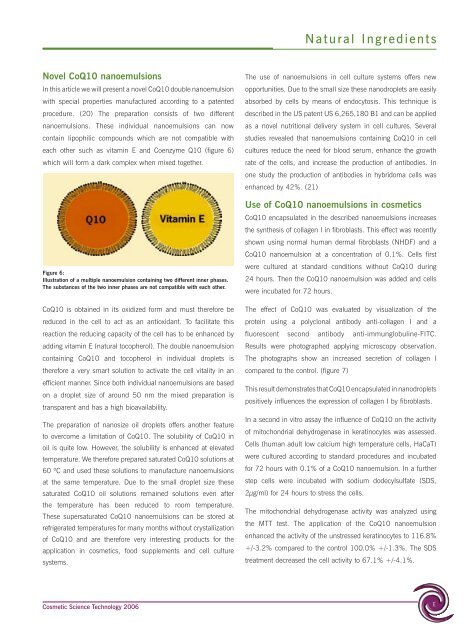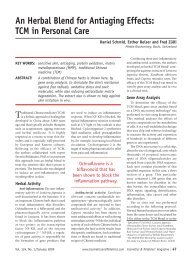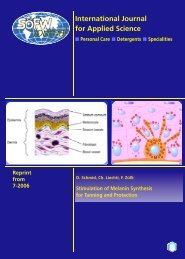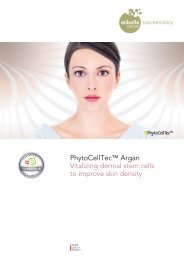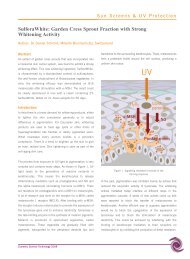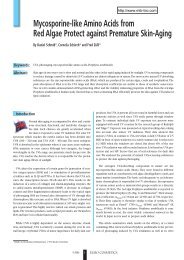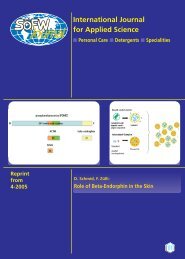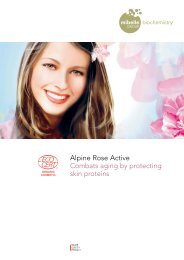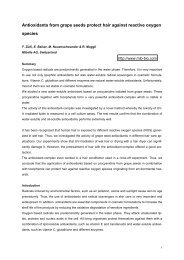Preparation and properties of coenzyme Q10 nanoemulsions
Preparation and properties of coenzyme Q10 nanoemulsions
Preparation and properties of coenzyme Q10 nanoemulsions
You also want an ePaper? Increase the reach of your titles
YUMPU automatically turns print PDFs into web optimized ePapers that Google loves.
Natural IngredientsNovel Co<strong>Q10</strong> <strong>nanoemulsions</strong>In this article we will present a novel Co<strong>Q10</strong> double nanoemulsionwith special <strong>properties</strong> manufactured according to a patentedprocedure. (20) The preparation consists <strong>of</strong> two different<strong>nanoemulsions</strong>. These individual <strong>nanoemulsions</strong> can nowcontain lipophilic compounds which are not compatible witheach other such as vitamin E <strong>and</strong> Coenzyme <strong>Q10</strong> (figure 6)which will form a dark complex when mixed together.Figure 6:Illustration <strong>of</strong> a multiple nanoemulsion containing two different inner phases.The substances <strong>of</strong> the two inner phases are not compatible with each other.Co<strong>Q10</strong> is obtained in its oxidized form <strong>and</strong> must therefore bereduced in the cell to act as an antioxidant. To facilitate thisreaction the reducing capacity <strong>of</strong> the cell has to be enhanced byadding vitamin E (natural tocopherol). The double nanoemulsioncontaining Co<strong>Q10</strong> <strong>and</strong> tocopherol in individual droplets istherefore a very smart solution to activate the cell vitality in anefficient manner. Since both individual <strong>nanoemulsions</strong> are basedon a droplet size <strong>of</strong> around 50 nm the mixed preparation istransparent <strong>and</strong> has a high bioavailability.The preparation <strong>of</strong> nanosize oil droplets <strong>of</strong>fers another featureto overcome a limitation <strong>of</strong> Co<strong>Q10</strong>. The solubility <strong>of</strong> Co<strong>Q10</strong> inoil is quite low. However, the solubility is enhanced at elevatedtemperature. We therefore prepared saturated Co<strong>Q10</strong> solutions at60 ºC <strong>and</strong> used these solutions to manufacture <strong>nanoemulsions</strong>at the same temperature. Due to the small droplet size thesesaturated Co<strong>Q10</strong> oil solutions remained solutions even afterthe temperature has been reduced to room temperature.These supersaturated Co<strong>Q10</strong> <strong>nanoemulsions</strong> can be stored atrefrigerated temperatures for many months without crystallization<strong>of</strong> Co<strong>Q10</strong> <strong>and</strong> are therefore very interesting products for theapplication in cosmetics, food supplements <strong>and</strong> cell culturesystems.The use <strong>of</strong> <strong>nanoemulsions</strong> in cell culture systems <strong>of</strong>fers newopportunities. Due to the small size these nanodroplets are easilyabsorbed by cells by means <strong>of</strong> endocytosis. This technique isdescribed in the US patent US 6,265,180 B1 <strong>and</strong> can be appliedas a novel nutritional delivery system in cell cultures. Severalstudies revealed that <strong>nanoemulsions</strong> containing Co<strong>Q10</strong> in cellcultures reduce the need for blood serum, enhance the growthrate <strong>of</strong> the cells, <strong>and</strong> increase the production <strong>of</strong> antibodies. Inone study the production <strong>of</strong> antibodies in hybridoma cells wasenhanced by 42%. (21)Use <strong>of</strong> Co<strong>Q10</strong> <strong>nanoemulsions</strong> in cosmeticsCo<strong>Q10</strong> encapsulated in the described <strong>nanoemulsions</strong> increasesthe synthesis <strong>of</strong> collagen I in fibroblasts. This effect was recentlyshown using normal human dermal fibroblasts (NHDF) <strong>and</strong> aCo<strong>Q10</strong> nanoemulsion at a concentration <strong>of</strong> 0.1%. Cells firstwere cultured at st<strong>and</strong>ard conditions without Co<strong>Q10</strong> during24 hours. Then the Co<strong>Q10</strong> nanoemulsion was added <strong>and</strong> cellswere incubated for 72 hours.The effect <strong>of</strong> Co<strong>Q10</strong> was evaluated by visualization <strong>of</strong> theprotein using a polyclonal antibody anti-collagen I <strong>and</strong> afluorescent second antibody anti-immunglobuline-FITC.Results were photographed applying microscopy observation.The photographs show an increased secretion <strong>of</strong> collagen Icompared to the control. (figure 7)This result demonstrates that Co<strong>Q10</strong> encapsulated in nanodropletspositively influences the expression <strong>of</strong> collagen I by fibroblasts.In a second in vitro assay the influence <strong>of</strong> Co<strong>Q10</strong> on the activity<strong>of</strong> mitochondrial dehydrogenase in keratinocytes was assessed.Cells (human adult low calcium high temperature cells, HaCaT)were cultured according to st<strong>and</strong>ard procedures <strong>and</strong> incubatedfor 72 hours with 0.1% <strong>of</strong> a Co<strong>Q10</strong> nanoemulsion. In a furtherstep cells were incubated with sodium dodecylsulfate (SDS,2µg/ml) for 24 hours to stress the cells.The mitochondrial dehydrogenase activity was analyzed usingthe MTT test. The application <strong>of</strong> the Co<strong>Q10</strong> nanoemulsionenhanced the activity <strong>of</strong> the unstressed keratinocytes to 116.8%+/-3.2% compared to the control 100.0% +/-1.3%. The SDStreatment decreased the cell activity to 67.1% +/-4.1%.Cosmetic Science Technology 2006E


